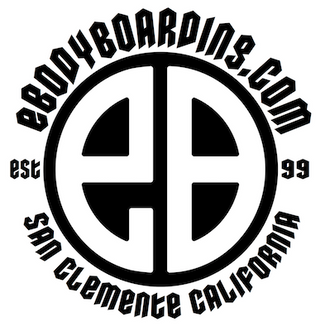How to ride a bodyboard
TIP: Don't over wax your board in the chest/stomach area! This will prevent you from making quick adjustments to your body position to perform various maneuvers. You want plenty of wax where your arms and hands go, but just a little in the chest/stomach areas of the board!

Your body should be comfortably balanced on the board with your hips near the back/tail end of the board…far enough back so that when you kick, your feet are UNDERWATER, not slapping the surface.That will enable you to get maximum power out of your kick.Slapping the surface wastes energy, gives very little forward motion and annoys those in your general vicinity as you splash them in the face unknowingly.
Elbows should be ON the board, not hanging off the edges, back arched, and hands should be gripping the top corners of the board while kicking.
If you want to switch to an arm paddle, (I frequently alternate between arm paddling and kicking), move forward on the board so your feet/legs are slightly lifted out of the water and the board's nose is slightly submerged.
Your one hand on the nose should be pushing down hard to keep the board flat so it planes as you gain speed as the wave moves under you.
Watch Vicki demonstrate how to push down on the nose, give a couple of good paddles with her other hand, and then scoot forward and assume her riding position.
Riding the wave:
Once you feel the wave pushing you, scoot forward on the board quickly and arch your back raising your chest and head up high.Now it's time to assume your riding position. That will be determined by which direction you're going- right or left.
Going right: Move your right hand to the TOP RIGHT CORNER of the board and your right elbow and forearm should be resting on the deck along the right edge. This helps you to hold your edge on the wave face.
(Perfect arm and hand position makes for easy directional changes. Note Vicki's inside arm along the left edge of her board with forearm and elbow down for edge control. Outside right hand is 1/3 of the way down the right edge of the board with elbow up for the "cantilever" effect. Pic: Tom Prince) I see many riders put their lead hand in the top center of the nose and even on the wrong corner. Don't do this!It impacts your ability to make quick directional changes.
Your right hand should be about 1/3 of the way down the right rail of the board with your elbow raised off the board acting as sort of a cantilever that enables you to push your left hand up and down to control the steering of the board.Put pressure on that outside rail with your right hand and you'll turn down the wave.Pull up with that hand and you'll turn up the wave.


(Jay slides a bit further back on the board to maintain control in the tube of this steep, hollow wave)

(Note Gianna's correct hand/body position for the cutback allows for good control going left)
Adapt your riding using the tips above and you'll see a rapid increase in your skill level, particularly with doing new maneuvers and gaining more speed!

